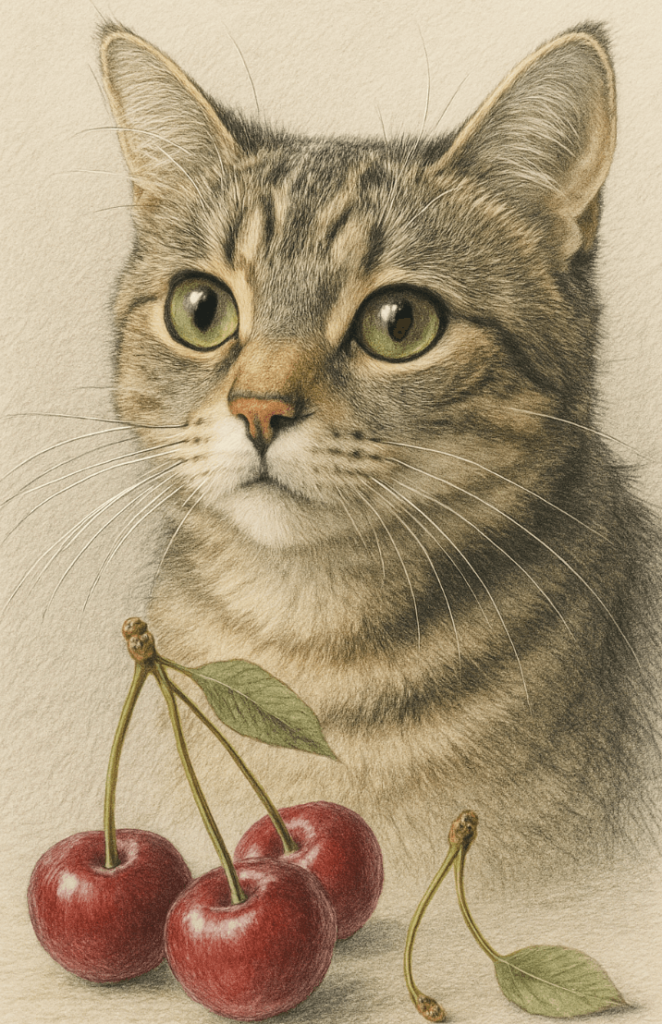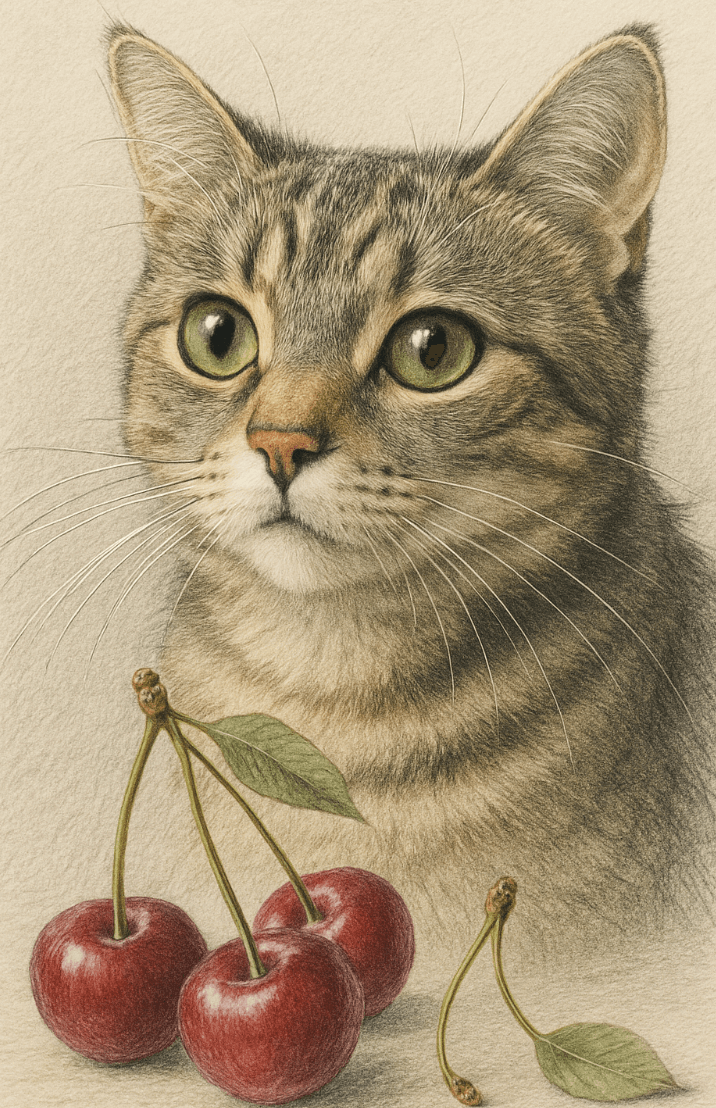Can Cats Eat Cherries? What You Need to Know
When it comes to sharing human food with our feline friends, it’s natural to wonder what’s safe and what’s not. Cherries, with their sweet and juicy appeal, might seem like a harmless treat to offer your cat. However, cats have unique dietary needs and sensitivities that require careful consideration. While cherries aren’t inherently toxic in small amounts, they do come with potential risks that every pet owner should understand. In this blog post, we’ll explore whether cats can eat cherries, the dangers involved, and safer alternatives to keep your furry companion healthy and happy.
Potential Risks of Feeding Cherries to Cats
While cherries may seem like a harmless snack, there are several risks associated with feeding them to your cat. Understanding these hazards is crucial to ensure your pet’s safety.
Choking Hazard from Pits:
Cherry pits are small but can easily become lodged in a cat’s throat, leading to choking or blockages in the digestive tract.Cyanide Poisoning Risk:
Cherry pits, stems, and leaves contain trace amounts of cyanogenic glycosides, which can release cyanide if ingested in large quantities.Upset Stomach:
The high sugar content in cherries can upset your cat’s stomach, causing diarrhea, vomiting, or gastrointestinal discomfort.Allergic Reactions:
Some cats may experience allergic reactions to cherries, such as itching, swelling, or difficulty breathing.Difficulty Digesting Fruit:
Cats are obligate carnivores and lack the enzymes needed to efficiently digest fruits like cherries, which can lead to digestive issues.
These risks highlight why it’s essential to exercise caution when considering offering cherries to your cat. Always prioritize their health over curiosity.
Benefits of Cherries (If Any) for Cats
While cherries are not a recommended part of a cat’s diet, they do contain some nutrients that could theoretically benefit cats in minimal amounts. However, these benefits are outweighed by the risks.
Antioxidants:
Cherries are rich in antioxidants, which help combat oxidative stress in the body.Vitamin C:
This vitamin supports immune function, though cats naturally produce their own Vitamin C and don’t require additional sources.Hydration:
The high water content in cherries can contribute to hydration, but plain water is a better option for cats.Fiber Content:
A small amount of fiber might aid digestion, but too much can cause gastrointestinal upset in cats.Low-Calorie Snack:
Cherries are low in calories, making them a potentially light treat—though safer alternatives exist.
Given the risks, any potential benefits of cherries for cats are negligible compared to the dangers they pose.
Check this guide 👉Can Cats Eat Peas? Best 7 Expert Tips!
Check this guide 👉Can Cats Eat Sardines? Best 7 Expert Tips!
Check this guide 👉Can Cats Eat Raspberries? Best 7 Expert Tips!

Safe Alternatives to Cherries for Cats | Risks of Unsafe Foods for Cats |
|---|---|
Plain cooked chicken (unseasoned) | Grapes and raisins (toxic to cats) |
Small pieces of banana | Chocolate (contains theobromine) |
Pumpkin puree (unsweetened) | Onions and garlic (can cause anemia) |
Blueberries (in moderation) | Alcohol (extremely toxic) |
Watermelon (seedless and cut into chunks) | Raw dough (can expand in the stomach) |
How to Safely Introduce New Foods to Your Cat
If you’re curious about expanding your cat’s diet, it’s important to introduce new foods gradually and safely. Here are some tips to ensure a smooth process.
Consult Your Veterinarian First:
Always seek professional advice before offering your cat unfamiliar foods, especially fruits like cherries.Start with Tiny Portions:
Offer only a small piece of the new food to monitor your cat’s reaction and avoid overwhelming their system.Observe for Allergic Reactions:
Watch for signs of allergies, such as itching, swelling, or gastrointestinal distress, after introducing a new food.Avoid Toxic Ingredients:
Never feed your cat foods that are known to be toxic, such as chocolate, onions, or grapes.Stick to Cat-Friendly Options:
Focus on foods specifically designed for cats or those known to be safe, like plain cooked meat or certain vegetables.
By following these guidelines, you can minimize risks and ensure your cat enjoys a varied yet safe diet.
Signs Your Cat May Have Eaten Something Harmful
Even with precautions, accidents can happen. Recognizing the signs of poisoning or digestive distress can help you act quickly to protect your cat.
Vomiting or Diarrhea:
These symptoms often indicate gastrointestinal upset caused by eating something harmful.Lethargy or Weakness:
A sudden lack of energy or unusual fatigue could signal toxicity or other health issues.Excessive Drooling:
Drooling may occur if your cat has ingested something irritating or toxic.Difficulty Breathing:
Labored breathing could indicate a severe reaction, such as cyanide poisoning from cherry pits.Loss of Appetite:
Refusal to eat is a common sign that your cat is feeling unwell after consuming something inappropriate.
If you notice any of these signs, contact your veterinarian immediately for guidance.
Common Mistakes to Avoid When Feeding Cats Human Food
Feeding cats human food requires careful consideration to avoid mistakes that could endanger their health. Here are some pitfalls to watch out for.
Assuming All Fruits Are Safe:
Many fruits, like cherries, grapes, and citrus, can harm cats despite being safe for humans.Ignoring Portion Sizes:
Even safe foods can cause problems if given in large quantities, leading to obesity or digestive upset.Offering Processed Foods:
Items like maraschino cherries or canned fruits often contain additives that are harmful to cats.Neglecting Allergies:
Not all cats react the same way to new foods; always watch for signs of allergies or intolerance.Skipping Veterinary Advice:
Consulting a vet before introducing new foods ensures your cat’s safety and dietary balance.
Avoiding these mistakes helps prevent accidental harm to your cat.
Alternatives That Satisfy Your Cat’s Curiosity
If your cat shows interest in trying new foods, there are plenty of safer alternatives that satisfy their curiosity without posing risks.
Cooked Chicken or Turkey:
Plain, unseasoned cooked poultry is a protein-rich treat that aligns with a cat’s dietary needs.Pumpkin Puree:
Unsweetened pumpkin aids digestion and can help regulate your cat’s bowel movements.Blueberries:
Rich in antioxidants, blueberries make a nutritious occasional treat in small amounts.Seedless Watermelon:
This hydrating fruit is a refreshing option, provided it’s free of seeds and served in moderation.Cat Grass:
Many cats enjoy nibbling on cat grass, which provides fiber and aids digestion.
These alternatives allow you to cater to your cat’s instincts while keeping them safe.
Understanding Your Cat’s Natural Diet and Preferences
Cats are obligate carnivores, meaning their bodies are designed to thrive on a meat-based diet. Understanding their natural preferences helps explain why certain foods, like cherries, aren’t ideal.
High Protein Needs:
Cats require diets rich in animal protein to support muscle development and overall health.Limited Ability to Process Carbs:
Unlike humans, cats lack the enzymes needed to efficiently digest carbohydrates found in fruits.Instinctual Hunting Behavior:
Their preference for meat stems from their evolutionary history as hunters, where prey provided essential nutrients.Selective Palates:
Cats are known for being picky eaters, often favoring familiar tastes and textures over novelty.Hydration Through Food:
Cats naturally obtain moisture from their prey, making wet food or hydrating snacks like watermelon more appealing than dry kibble alone.
By recognizing these traits, you can better tailor your cat’s diet to meet their unique needs.
Frequently Asked Questions About Cats and Cherries
Are cherries toxic to cats?
While the flesh of cherries isn’t highly toxic, the pits, stems, and leaves contain compounds that can release cyanide, making them dangerous.
Can cats eat maraschino cherries?
No, maraschino cherries are heavily processed and contain added sugars, artificial flavors, and preservatives that are unhealthy for cats.
What should I do if my cat eats a cherry pit?
Monitor your cat closely for signs of distress, such as vomiting or difficulty breathing, and contact your vet for advice.
How much cherry is safe for cats?
Even small amounts of cherry flesh should be avoided due to potential digestive issues and cyanide risks.
What fruits are safe for cats?
Safe options include small amounts of blueberries, seedless watermelon, or plain pumpkin puree. Always consult your vet first.
Prioritizing Your Cat’s Health When It Comes to Food
Feeding your cat cherries may seem like a harmless indulgence, but the risks far outweigh any potential benefits. As obligate carnivores, cats thrive on a diet primarily composed of animal-based proteins, and introducing human foods like cherries can disrupt their delicate systems. By understanding the dangers, opting for safer alternatives, and consulting your veterinarian, you can ensure your cat stays healthy and happy. Remember, your feline friend relies on you to make the best dietary choices for them—so always prioritize their well-being above all else.
Cat Fever Treatment: Best 7 Expert Tips! Discover expert advice on identifying, managing, and treating fever in cats to ensure their quick recovery and well-being.
Understanding Meloxicam for Cats: Best 7 Expert Tips! Learn how to safely administer meloxicam, manage side effects, and ensure your cat's comfort with expert advice on feline pain relief.
Amoxicillin for Cat UTI: Best 7 Expert Tips! Discover safe usage, dosage guidelines, and expert advice on treating feline urinary tract infections effectively with amoxicillin.
Understanding Cat Cancer Treatment: Best 7 Expert Tips! Discover expert advice on managing feline cancer, from early detection to treatment options, ensuring your cat’s health and comfort.





